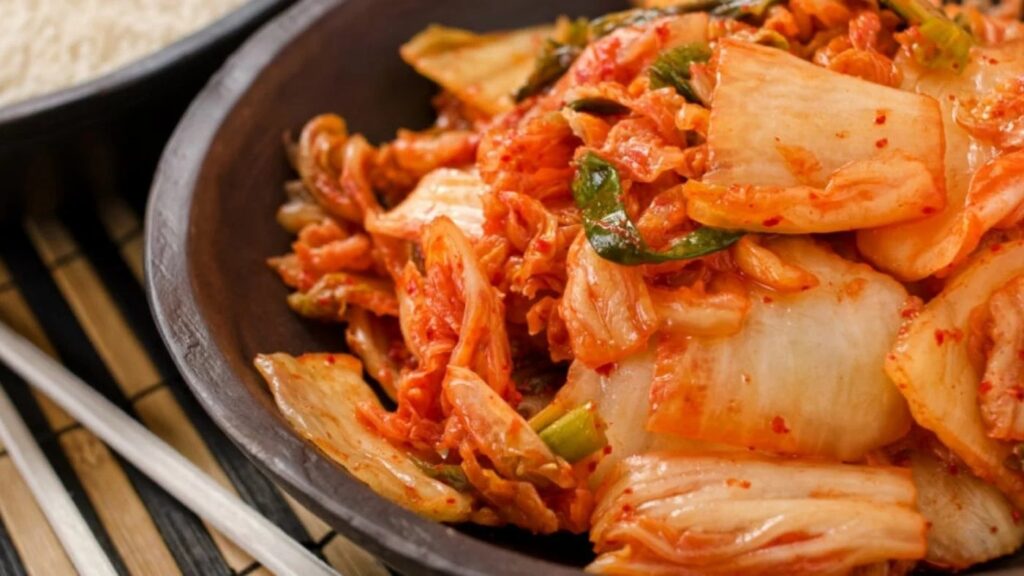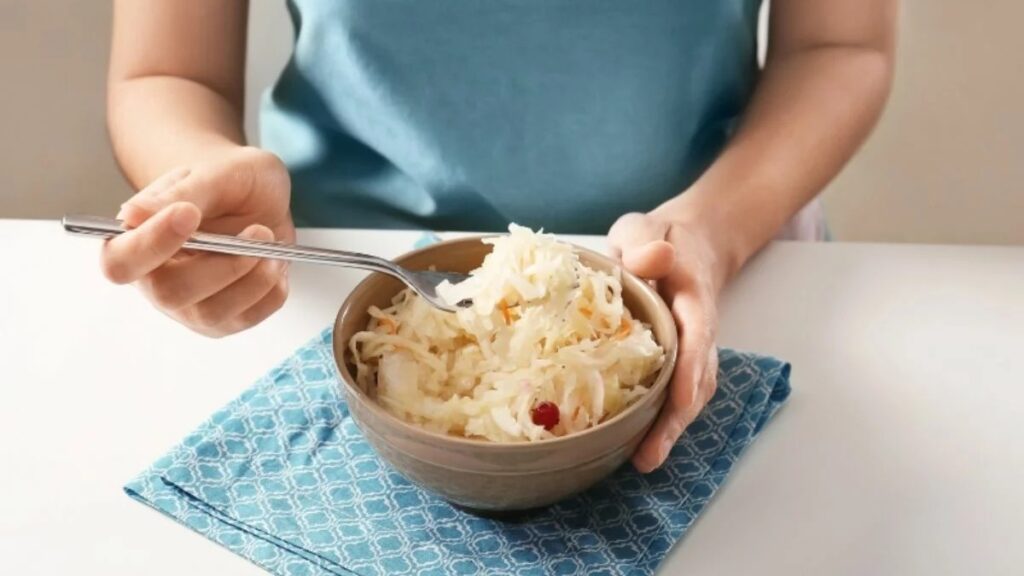Take advantage of the summer harvest to turn cucumbers into delicious, crunchy pickles. Who doesn’t love adding a crunchy pickle with just enough tang to a burger? But be careful! Pickles are also very easy to fail…
What a shame to open a jar and discover that the pickles have gone soggy!
Even if they’re still perfectly edible and tasty, everyone will tell you that it’s the crunchiness of the pickles that matters!
However, it’s very easy to make good, naturally fermented pickles if you know a few tricks.
This article will reveal the secrets to successful pickles, give you a recipe for super crunchy fermented pickles, and answer all your questions!
Looking for a quick and easy solution? Start your adventure with a complete pickle kit.
Go straight to the section that interests you!
- Why do pickles go soft?
- 10 tips for crunchy pickles
- Recipe for crunchy pickles
- Frequently asked questions
Pickled or Fermented Cucumber?
Many traditional recipes use vinegar and spices to turn cucumbers into pickles. These are pickled cucumbers, also known as vinegar cucumbers or marinades.
No vinegar is added to a lacto-fermentation pickle recipe, just salt and water. It’s the fermentation process that makes the cucumbers tangy and rich in health-promoting bacteria!
To find out more, see What are the differences between canning and lacto-fermentation?
The tips for keeping pickles crunchy generally apply equally to pickled and fermented cucumbers.
Why Do Pickles Become Soggy (Soft)?
As soon as they’re picked, cucumbers begin a long process of softening.
This natural phenomenon is caused by enzymes present in the cucumber, which gradually break down its structure, making it softer and softer.
By applying our tips, we can significantly slow down this softening process.
How Do I Make Crunchy Pickles?
There are several tricks for keeping pickles crunchy during fermentation or canning. Even if you can’t apply them all, try to apply as many as possible.
The first 7 tips apply to all pickle recipes (pickled and fermented). The last 3 tips only apply to fermented pickles.
Here are 10 tips for crunchy pickles:
1. Choose Freshly Harvested Cucumbers
As soon as cucumbers are picked, the softening process begins. So the sooner you jar them the better!
We’re not telling you to ferment your cucumbers directly in the garden (although…), but, if possible, put them in jars within 2 to 3 days of harvesting.
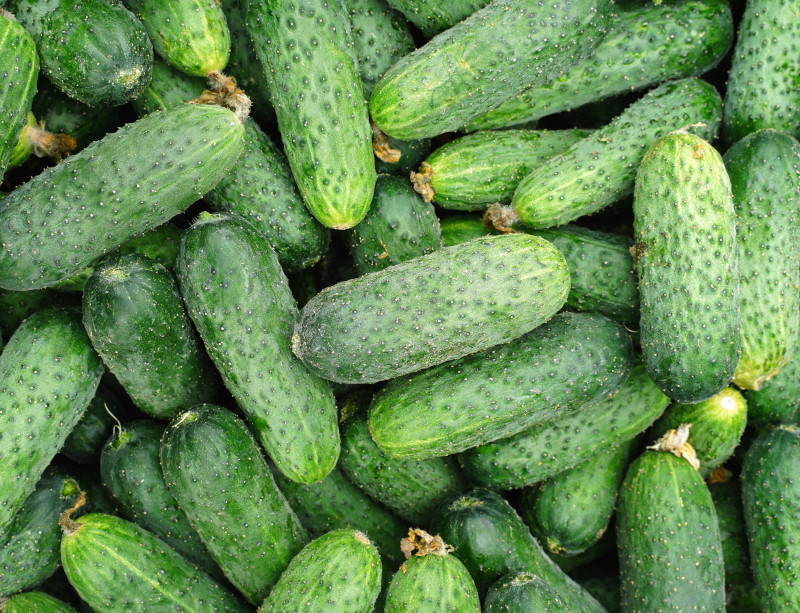
2. Use the Right Cucumber Varieties
Choosing the right variety of cucumbers is important if you want crunchy pickles. Some varieties, such as English cucumbers, become particularly soft during fermentation.
Choose small, firm cucumbers. Pickling cucumbers, Kirby and Lebanese cucumbers give good results.
3. Cut off the Ends of Cucumbers
The flowers and stems of cucumbers contain enzymes that speed up the softening of pickles.
To avoid this, remove the ends of the cucumbers with a knife before placing them in jars.
4. Soak Cucumbers in Ice Water
During transport and storage (especially for cucumbers bought at the market), cucumbers can lose some of their moisture. To rehydrate them, soak them for a few hours in ice water.
Place your cucumbers in a large container and cover them with water and ice cubes so that they are well submerged. You can also leave them in the fridge.
The ice water bath can last from 3 hours to an entire night.
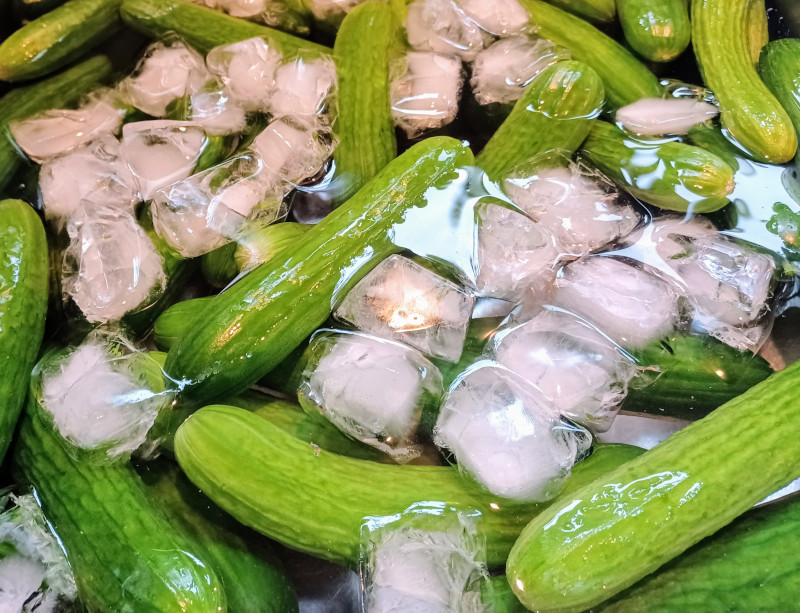
5. Use Calcium Chloride
Calcium chloride (CaCl2), sometimes known as “pickle crisp”, is a type of salt that helps preserve the crunchiness of food. It is used in the food industry to help preserve the texture of canned fruit and vegetables.
Sea salt is sodium chloride. In this case, we’re talking about calcium chloride!
These little granules, which dilute quickly in water, are THE trick to crunchy pickles, as they prevent the enzymes from softening the pickle during lacto-fermentation.
It does not replace salt; it is used as a supplement.
Quantity: ¼ to ¾ tsp. calcium chloride for a 1L jar.
Adjust according to the size of your jars.
6. Add a Source of Tannin
Tannins work against softening enzymes and help keep pickles crunchier. They can be found in various sources, such as grape leaves, oak leaves, raspberry leaves, black tea, etc.
Add some directly to your jars!
7. Use Enough Salt
The more salt you use, the more crispiness you’ll retain. However, too much salt won’t taste good. The idea is to find the right balance according to your taste.
Quantity: 1.5 to 2 tbsp. salt per 1L jar
This represents 2.5 to 3.5% salt. Adjust proportionally for different jar sizes. To understand how salt is calculated, see How Much Salt to Add to Make a Brine?
8. Don’t Add Bacteria
Some lacto-fermentation recipes call for the addition of sauerkraut juice to guide the fermentation process (this is known as ‘backslopping‘). However, this is not recommended for pickles.
Bacteria present at the start and end of fermentation are different. For most recipes, this does not affect the finished product. However, with pickles, it makes them softer more quickly.
9. Keep Fermentation Short
The longer the fermentation process, the softer the vegetables become. To limit this effect, only leave your pickles to ferment for a few days at room temperature, then refrigerate.
A fermentation period of 5 to 8 days is ideal.
10. Leave the Pickles to Ferment in a Cool Place
Ideally, the fermentation temperature should not be too high.
If you have a cold room or a cool basement, ferment your pickles there (and all your lacto-fermentations, for that matter). The ideal temperature is around 17°C.
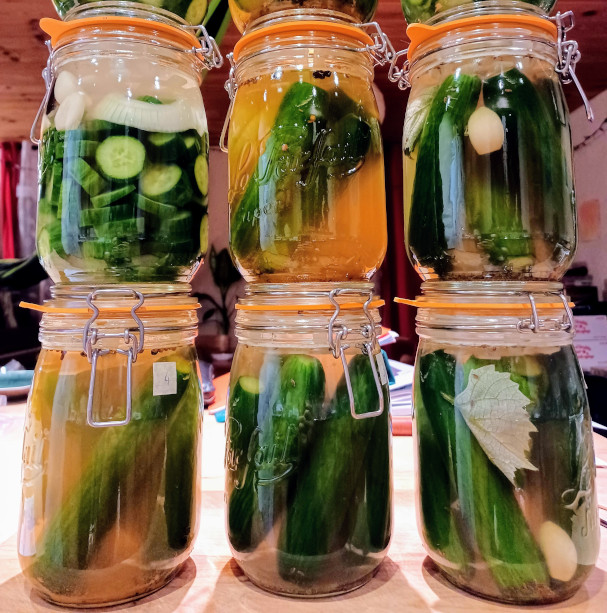
Crunchy Pickles Checklist!
You don’t have to apply all our tips to get great naturally fermented pickles. It’s up to you to find the formula that works best for you. Here are two examples.
“Not very salty, but very crunchy”
✅ Small, firm cucumbers
✅ Soak for 3 hours in a tank of cold water
✅ Cucumber ends cut off
✅ 1.5 tbsp. salt (25 g) per 1L jar
✅ ¼ tsp. calcium chloride
✅ 7 days of fermentation on the countertop
“Traditional method”
✅ Small firm cucumbers harvested in the morning from the garden
✅ Soaked for 3 hours in a tank of cold water
✅ Cucumber ends cut off
✅ One grape leaf per jar
✅ 2 tbsp. salt (30g) per 1L jar
✅ 10 days of fermentation in the cold room
Whatever the method, once fermented, they will keep for over a year in the fridge!
For more details on how to put this into practice, see How to Make Lacto-Fermentations, and follow the recipe!
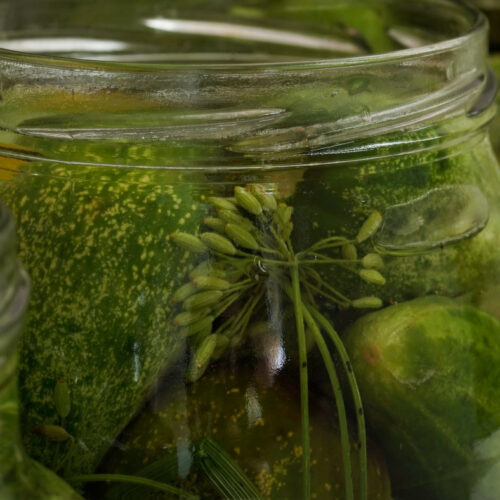
Crunchy Pickles Fermented With Garlic Recipe
Ingredients
- 7 freshly picked pickling cucumbers
- 3 garlic cloves
- 1 ½ tbsp salt
- ¼ tsp calcium chloride
- 1 tsp pickling spice or dried dill
- water
Steps
Soaking
- Cut the ends, stems, and flowers off the cucumbers.
- Place the cucumbers in an ice water bath. Leave to stand for at least 3 hours.
Preparation
- Place the salt, calcium chloride, spices, and garlic cloves in the jar.
- Pile the cucumbers vertically.
- Add the water until it covers the cucumbers.
- Place the insert on top of the cucumbers, folding the flaps upwards.
- Close the lid.
- Gently shake the jar to dissolve the salt. Replace the insert if necessary.
Fermentation
- Place the closed jar on a plate in case it overflows during fermentation.
- Let it ferment in a cool room for 7 days.
- Refrigerate.
Notes
And there you have it! Now you can enjoy satisfying crunches and snaps!
Enjoy your pickles in your burgers, sandwiches, with a raclette, or simply straight from the jar, with your fingers.
Frequently Asked Questions
My Pickles Are Soft, Can I Make Them Firmer?
If you start with a soft or soggy cucumber, there’s no hope of remission: the pickle is doomed to softness.
Why Has the Garlic in My Pickles Jar Turned Blue?
It’s normal for garlic to change colour! It’s a molecule in the garlic that reacts with the acidity of the fermentation. To find out more, see Why Does Fermented Garlic Turn Blue?
Can I Add Boiling Water to Cucumbers to Keep Them Crunchy?
Pouring boiling water over cucumbers, or blanching them, destroys the enzymes present in pickles.
However, this process will also destroy the microorganisms present on the cucumbers. This technique is not recommended for fermentation.
Can I Use Alum to Make Fermented Pickles?
Alum is an additive often used in pickles, but it can be dangerous in too large quantities. We prefer not to use it in lacto-fermentation.
Can I Use Lime to Make Lacto-Fermented Pickles?
Lime has long been used to make crunchy pickles. However, after soaking in lime, the cucumbers should be rinsed thoroughly. Lime can also affect the acidity of the mixture. We prefer to use calcium chloride.
What Should I Do With Soggy Pickles?
Are your lacto-fermented pickles past the point of no return and have a soft, mushy texture in your mouth?
Once the tears have subsided, pull yourself together! All is not lost. 💪
Pickles can be chopped and mixed with a little sugar to make homemade relish.
The brine can be used to deglaze vegetables, marinate tofu, or make gut shots.
